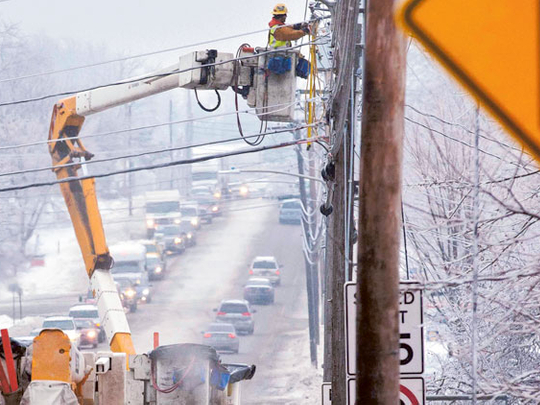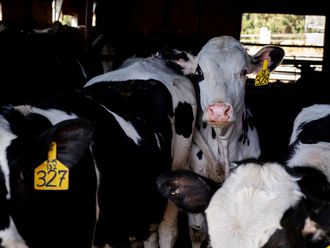
Augusta: Utility crews from Maine to Michigan and into Canada worked to restore power to more than half a million homes that were left in the dark by last weekend’s ice storm, which has been linked to 27 deaths.
In the United States, the death toll from the storm reached at least 17 on Christmas day, from traffic accidents and carbon monoxide fatalities.
In Canada, 10 people were reported dead, including five who were reported dead from apparent carbon monoxide poisoning.
Police said two people in Ontario died after using a gas generator to heat their blacked-out home northeast of Toronto. Police in Quebec said carbon monoxide poisoning was believed to be the cause of three deaths in a chalet on the province’s North Shore. Earlier, five people were killed in eastern Canada in highway crashes blamed on severe weather conditions.
The ice storm last weekend was one of the worst to hit during a Christmas week, and repair crews were working around the clock to restore service.
As temperatures plunged into the low single digits (below minus 7 Celsius) in Toronto, authorities reported a dramatic jump in calls for suspected carbon monoxide poisoning, responding to 110 calls in a 24-hour period. Officials said they typically see 20 such calls a day.
“I understand they want to keep warm, but you cannot do this. This is deadly,” Toronto Mayor Rob Ford said on Tuesday as the city issued an extreme cold weather alert.
Fire officials warned residents not to use any appliance that burns inside a home, and even cautioned against using a lot of candles.
In Toronto, about 72,000 customers remained without power Christmas morning — down from 300,00. Elsewhere in Ontario, about 30,000 customers were still without power. In Quebec, some 28,000 customers remained without power. In New Brunswick, just under 30,000 customers were still in the dark.
Tens of thousands of homes were still without power on Wednesday in Michigan, down from more than 500,000 at the storm’s peak. Maine had about 60,000 without power, down from more than 100,000.
Canadian utility officials warned that some customers could be without power until Saturday.
The US National Weather Service said more snow is forecast to roll into the Great Lakes and Midwest by Wednesday morning.
In Canada, five people were reported dead from apparent carbon monoxide poisoning. Police said two people in Ontario died after using a gas generator to heat their blacked-out home northeast of Toronto. Police in Quebec said carbon monoxide poisoning was believed to be the cause of three deaths in a chalet on the province’s North Shore.
Earlier, five people were killed in eastern Canada in highway crashes blamed on severe weather conditions.
In the US, the nationwide death toll from the storm reached at least 14 on Tuesday, when a 50-year-old man in Knox, Maine, was overcome by carbon monoxide fumes from a generator. It was the second reported death attributed to fumes from a generator during the storm. Police in Michigan also attributed two deaths in a traffic collision that happened on Monday to the storm.
As temperatures plunged into the low single digits (below minus 15 Celsius) in Toronto — where nearly 80,000 customers remained without power late on Tuesday — authorities reported a dramatic jump in calls for suspected carbon monoxide poisoning, responding to 110 calls in a 24-hour period. Officials said they typically see 20 such calls a day.
“We’re looking at approximately six times as many calls,” Toronto Mayor Rob Ford said as the city issued an extreme cold weather alert.
“I understand they want to keep warm but you cannot do this. This is deadly.”
Fire officials warned residents not to use any appliance that burns inside a home, and even cautioned against using a lot of candles.
In Toronto, where 300,000 customers lost power at the height of the storm, crews from Ottawa, Windsor, Manitoba and Michigan were helping local teams with their efforts.
Elsewhere in Ontario, more than 44,000 customers were still without power early on Wednesday. In Quebec, some 28,000 customers remained without power. In New Brunswick, just over 29,000 customers were still in the dark, and about 300 were without power in Nova Scotia.
Canadian utility officials warned that some customers could be without power until Saturday.
Some US states kept emergency shelters open for people without power.
The number of customers in Maine without power spiked to more than 100,000 on Tuesday. Central Maine Power said its goal was to use more than 1,000 workers to restore power for all customers by Thursday night, while other utilities in Maine warned customers they could be without electricity until Friday.
That was the case, too, in Michigan, where Jackson-based Consumers Energy — the state’s largest utility — said it hadn’t had this many outages during any Christmas week, since its founding 126 years ago. Close to 17 per cent of its 1.8 million electric customers lost power during the storm that hit late on Saturday, roughly 152,000 remained without it on Tuesday.
At their home outside Flint, Michigan, John Potbury and his family of four lost electricity at 6am on Sunday and since then they have been living in a single bedroom warmed by generator-powered space heaters.
Lights on the Christmas tree were dark, of course, but there was no power to the freezer, either. “Even though the house is freezing cold, the freezer items were starting to thaw out,” Potbury said.
That wasn’t the greatest concern, however, for his kids, 8-year-old Jacob and 5-year-old Jackson. Potbury said he told them on Tuesday, “Santa runs on reindeer power, not electricity, so he should be OK. ”












